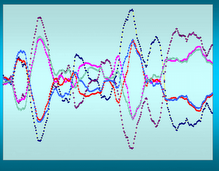I like using the LRS in two ways. First I use the bands on each side of the LRS itself as a trading zone. For that reason I use a 45-period LRS. I’ve noted that stocks that close on the bottom line are prime candidates for rebound. I’ll discuss this method in more detail in another post. Today I want to talk about the LRS transition method.
Obviously because the linear regression method outputs a “slope” that slope can be either positive or negative or neutral. I’ve noticed that when the slope transitions from positive to negative a window opens for a little while for the stock to go up (and vice versa from negative to positive). The figure below of COCO shows this effect.
For Longs:
1. Linear Regression Slope (45 periods) transitions from positive to negative.
2. RSI(14) is in oversold territory
3. Stochastic RSI(14) is in oversold territory
4. Several periods later the stock prints a “buy-me” pattern.
Note that the stock is at the lower band of the LRS. This doesn’t necessarily happen.
For Shorts:
5. The LRS transitions from negative to positive
6. RSI(14) is in overbought territory
7. Stochastic RSI(14) is in overbought territory
8. Several periods later the stock prints a “sell-me” pattern.
Just prior to the transition the stock’s high touched the upper band of the LRS. Again this is not a necessary factor in the method.
While this doesn’t seem incredibly intuitive (a negative going slope signaling a positive going stock and vice versa) most TA is based on extremes within the confines of the stock’s normal price excursion or variances from the norm and not on direct cause and effect. Think about it for awhile and you would agree – if it were that easy – everyone would be rich.
The figure below for YHOO shows another example, this time the stock didn’t go to extremes before the transition occurred. Also the effect was more rapid. Note that you have to be ready for the “buy-me” and “sell-me” prints because they can occur soon after the transition. On the “sell-me” side the stock was hurried along by a bad earnings report among other bad earnings reports (2Q 2006).

The figures are screen caps from a wonderful on-line software program provided by stockfetcher.com. Stockfetcher is for the sophisticated user who wants to “roll his own” or for the user who wants a set of canned filters using all of the most modern TA methods. They provide a free, try me capability. Warning - don’t try it or you will want to subscribe to it.


1 comment:
supreme clothing
yeezy 500 blush
longchamp handbags
steph curry shoes
adidas yeezy
yeezy supply
golden goose
supreme hoodie
yeezy shoes
balenciaga trainers
Post a Comment